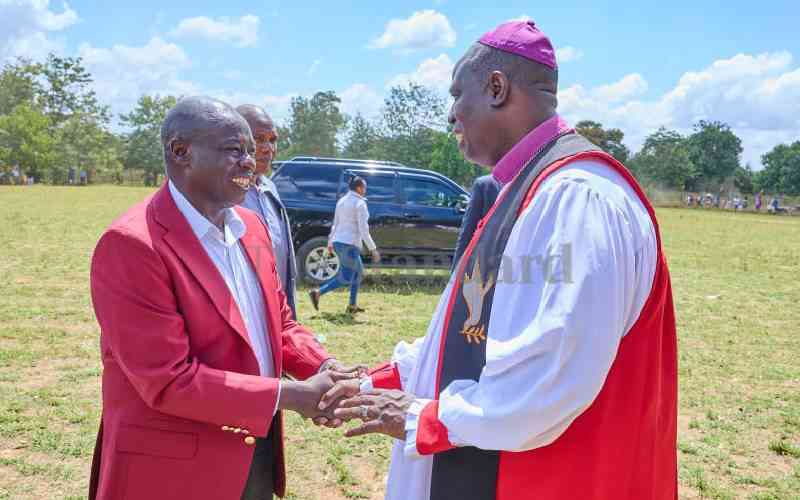Ordinarily, many Kenyans associate fishing with communities living along the Indian Ocean coast, Lake Turkana and the smaller Rift Valley lakes of Baringo and Naivasha, in addition to other minor lakes and rivers.
And off all fishing communities in the country, the Luo form the majority. What many would not know are the great lengths they took in pursuit of fishing that they are today to be found in remote areas such as Kiamburu dam on the border of Embu and Machakos counties.
The settlement of the Luo came forth to Kisumu Ndogo, a cosmopolitan beach settlement on the dam’s shores, where they have harmoniously co-existed with other communities from Western Kenya and Mt Kenya regions for decades.
Over 100 people, who trace their ancestors to the Luo, Luhya, Kamba, Mbeere, Embu, Kikuyu and coastal communities reside in the tiny settlement on the slopes of Mt Kenya, which can only be accessed through a rough, bushy path.
Every evening, fishermen set out into the bowels of the dam to fish and row their boats back in the morning with their catch to waiting traders .
On this chilly and windy morning, Collins Odhiambo and his colleague are met by a handful of fish traders patiently waiting to buy their catch.
After about 15 long hours in the dam pulling nets and hooks, their catch weighs just seven kilogrammes, mainly mud fish, which they sell at Sh300 per kilo. Other fish species in the dam include common cap, tilapia and eels.
A few minutes later, another boat operated by two men arrives and their catch is much bigger at 23 kilogrammes, which they sell at Sh6,600.
The take-home for each fisherman depends on their luck; they can walk home almost empty handed or on the best day, catch up to 50kgs. Odhiambo, who hails from Siaya county, first settled at Masinga Dam after a relative tipped him that fishing was lucrative there.
He later moved to Kiambere Dam and when the fish stocks there dwindled, he relocated to Kisumu Ndogo, where he is among the about 50 fishermen who form part of the local community.
The construction of Seven Forks hydroelectric dams in the upper Tana River basin attracted hundreds of fishermen, mainly from the Luo community. Most of these came as labourers, but have since called the area home.
The scheme consists of seven dams, the others being Kindaruma and Gitaru. They were built between 1974 and 1999.
Apart from being hired to provide labour, other members of the Luo and Luhya communities were brought in to catch the fish so as to control their numbers and prevent them from interfering with the proper operations of hydropower stations.
“When I settled here, I could not believe my eyes when I saw people from my community in their hundreds living peacefully with other communities from the Mt Kenya region,” recalls Odhiambo.
He adds that being a fisherman in such a remote area is much better than the kind of life his kinsmen who left their ancestral lands for the cities are leading, with many of them living in slums.
Stay informed. Subscribe to our newsletter
Daniel Asigo, who hails from Kakamega, is one of most successful fishermen in Kisumu Ndogo. He settled in the area in 1996 and now owns most of the boats operating in the dam, which he leases for Sh200 per day.
A new wooden boat costs Sh17,000, which many of the fishermen cannot afford. In total, there are about 30 boats at Kisumu Ndogo.
Asigo’s daughter, Irene Anyango, operates a fish eatery at Kivaa market where she fries fish and sells at a profit of about Sh300 per kilogramme.
She sells the biggest fish for about Sh1,500 and has employed an assistant at her eatery.
At Kivaa market, which is about five kilometres from the beach, there are seven fish eateries. Other traders sell their fish at Kiritiri market, Embu, Thika and even Nairobi. There are many other jobs available in Kisumu Ndogo. Some locals earn a livelihood by slaughtering fish to remove the innards, while others operate food kiosks to feed the hungry and tired fishermen.
Asingo says people frequently tour the area to catch a glimpse of “Luos in Diaspora” but many are disappointed the place only boasts of a few shack structures.
But having become culturally assimilated, none of the locals has any intention of tracing their roots.
At the dam, for instance, the Mbeere and Kamba communities started practicing fishing after encountering the Luo.
A case in point is Charles Kyalo, who hails from the nearby Kivaa market. He has been a fisherman for the last 20 years and has no regrets as he is able to put food on the table and take care of other family needs.
The interaction has also resulted in intermarriages and multi-lingualism.
Most locals do not suffer language barriers. For instance, Irene, a Luo, can speak fluently in Kikamba and Kimbeere languages, which she learnt when she settled in Kisumu Ndogo.
A famous fisherman by the name Thomas Obiero is credited with training fishing to many locals. Fisherman James Ochieng’ is also the chairman of Kisumu Ndogo village. He landed in the area on invitation of his brother who was an engineer at Kamburu power station.
Jane Anyango, who is in her fifties and hails from Usenge, settled in Kisumu Ndogo in 2006.
She first came there from Masinga dam where she had accompanied her late sister and now runs a makeshift hotel selling deep fried fish and other foods to the fishermen and traders.
“There were many Luos when we first landed here but most of them have since left after fish yields dwindled and business returns fell,” she said.
 The Standard Group Plc is a
multi-media organization with investments in media platforms spanning newspaper
print operations, television, radio broadcasting, digital and online services. The
Standard Group is recognized as a leading multi-media house in Kenya with a key
influence in matters of national and international interest.
The Standard Group Plc is a
multi-media organization with investments in media platforms spanning newspaper
print operations, television, radio broadcasting, digital and online services. The
Standard Group is recognized as a leading multi-media house in Kenya with a key
influence in matters of national and international interest.
 The Standard Group Plc is a
multi-media organization with investments in media platforms spanning newspaper
print operations, television, radio broadcasting, digital and online services. The
Standard Group is recognized as a leading multi-media house in Kenya with a key
influence in matters of national and international interest.
The Standard Group Plc is a
multi-media organization with investments in media platforms spanning newspaper
print operations, television, radio broadcasting, digital and online services. The
Standard Group is recognized as a leading multi-media house in Kenya with a key
influence in matters of national and international interest.







